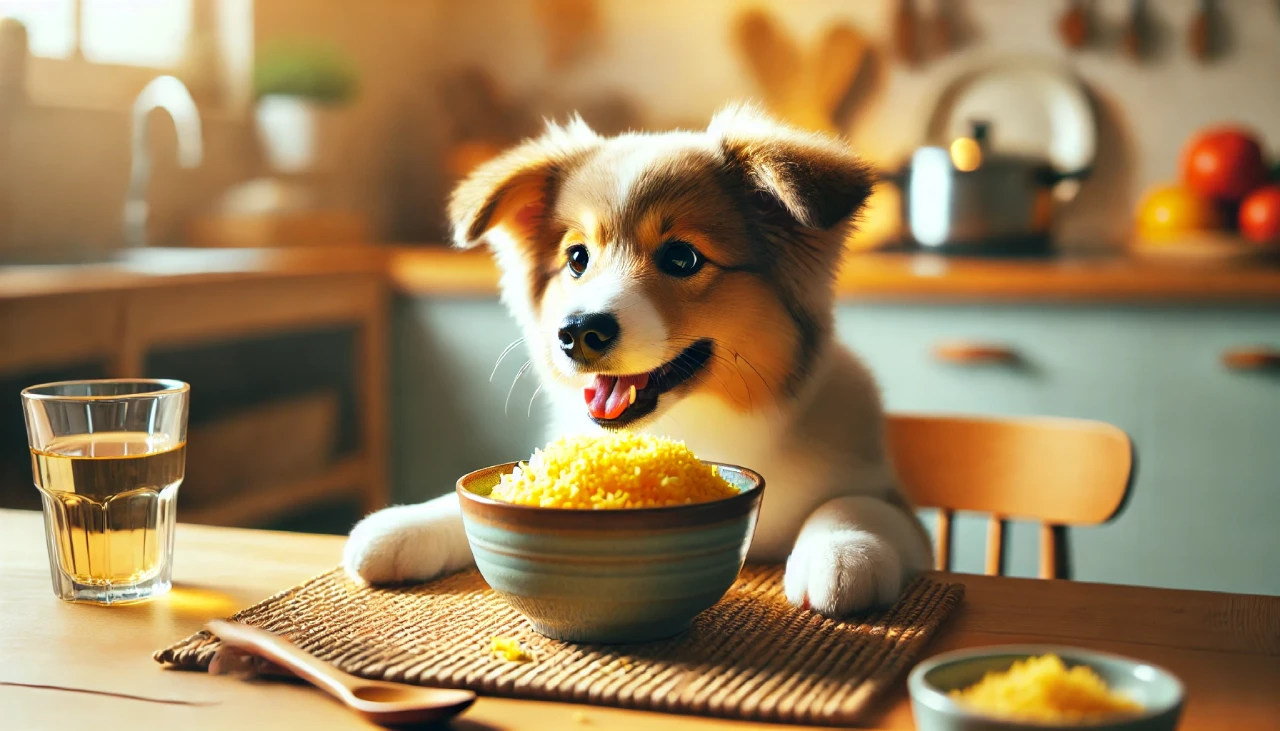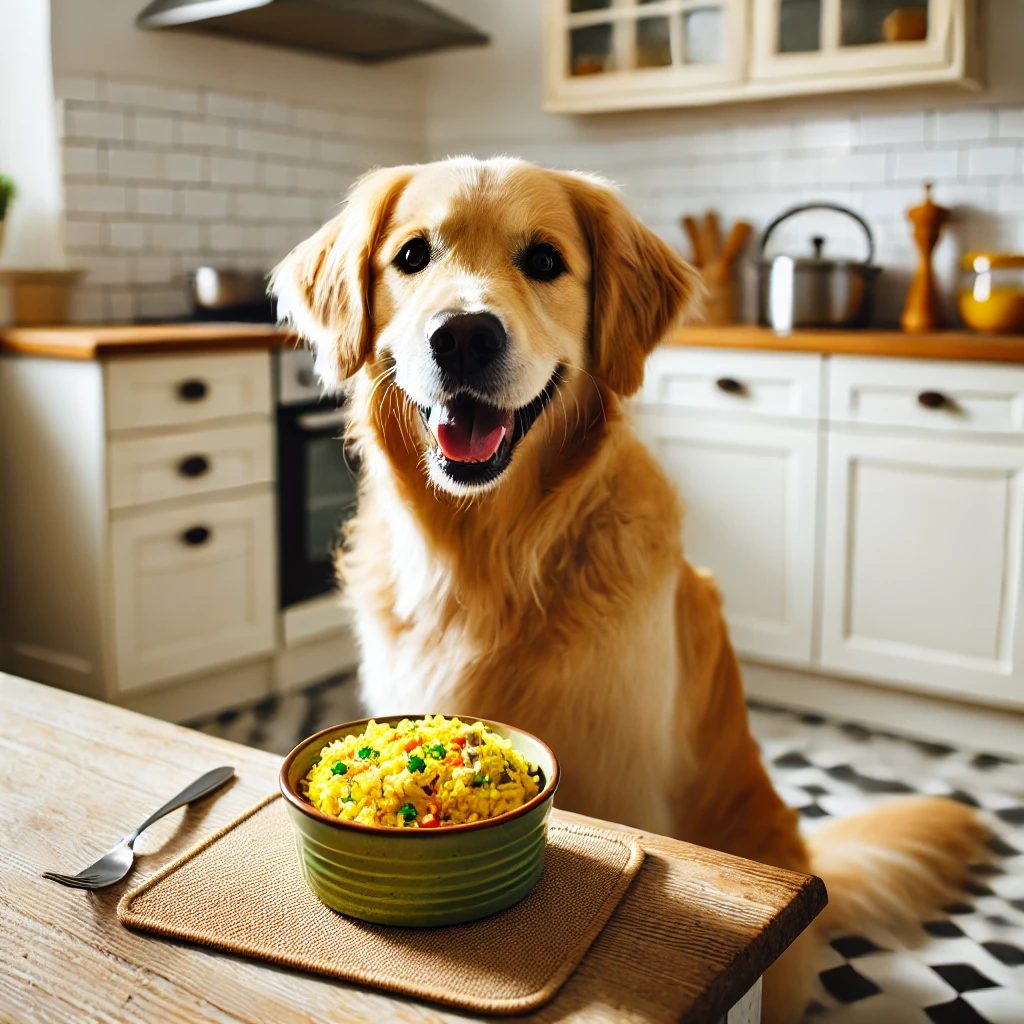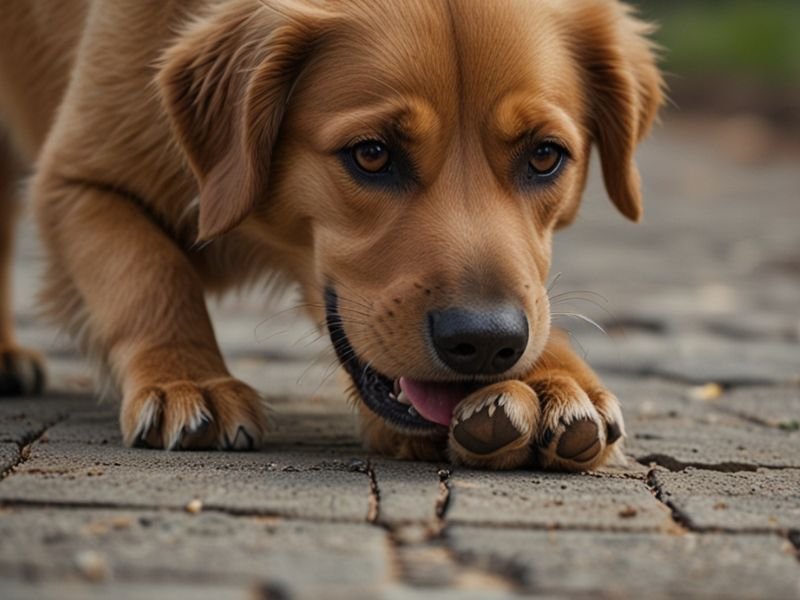Rice, a staple in many households, comes in a fascinating array of colors – each with its unique nutritional composition.
But what about yellow rice? If you’re a dog owner, it’s natural to wonder whether this delightful side dish is safe for your furry friend to indulge in.
After all, our canine companions are notorious for their inquisitive taste buds, often leaving us scrambling to determine what’s beneficial or potentially harmful to their health.
Table of Contents
- Can Dogs Eat Yellow Rice? The Nutritional Benefits: A Comprehensive Guide
- What is Yellow Rice and Its Nutritional Value
- Basic Nutritional Needs of Dogs
- Is Yellow Rice Safe for Dogs? Understanding Potential Risks and Precautions
- Feeding Fido: How to Introduce Yellow Rice to Your Dog’s Diet
- Adding Variety to Your Dog’s Meals: Creative Ways to Incorporate Yellow Rice
- Yellow Rice Recipes for Picky Eaters: Tasty and Healthy Options for Canine Palates
- Alternative Options for Dogs with Dietary Restrictions: Exploring Yellow Rice Substitutes
- The Final Verdict: Expert Opinions on Dogs and Yellow Rice
- People Also Ask:
- Conclusion:
Can Dogs Eat Yellow Rice? The Nutritional Benefits: A Comprehensive Guide
Yellow rice is a popular dish in many cuisines, and as a dog owner, you may wonder if it is safe to share this vibrant and flavorful food with your furry friend. In this comprehensive guide, we will explore the nutritional benefits of yellow rice for dogs, helping you make informed decisions about incorporating it into their diet.
Yellow rice is typically made by combining white rice with ingredients such as turmeric, saffron, or annatto powder, giving it the characteristic yellow color. It is a good source of carbohydrates, providing energy for your dog’s daily activities. Additionally, it contains essential nutrients such as protein, dietary fiber, and various vitamins and minerals that contribute to your dog’s overall health.
Carbohydrates are an important component of a dog’s diet, providing them with the energy they need for their daily activities. While dogs are primarily carnivores, they can digest and utilize carbohydrates to fuel their bodies. Yellow rice offers a tasty and easily digestible source of carbohydrates for your canine companions.
Furthermore, yellow rice contains dietary fiber, which aids in digestion and helps maintain a healthy gastrointestinal system. It can prevent constipation and regulate bowel movements in dogs, promoting a healthy digestive tract.
In terms of nutrients, yellow rice contains essential vitamins and minerals that contribute to your dog’s overall health. It is rich in B vitamins, including thiamine, riboflavin, and niacin, which support a healthy metabolism and play a vital role in the production of energy. Additionally, yellow rice is a source of minerals like iron, magnesium, and potassium, which are essential for various physiological functions in a dog’s body.
By incorporating yellow rice into your dog’s diet in moderation, you can provide them with a delicious and nutritious meal option. However, it is crucial to remember that a balanced and complete diet tailored to your dog’s specific needs is essential. Always consult with your veterinarian before introducing any new food into your dog’s diet to ensure that it is suitable for their individual health requirements.
In conclusion, yellow rice can be a healthy addition to your dog’s diet, providing them with essential nutrients, energy, and fiber. Remember, moderation is key, and it should always be part of a balanced diet alongside high-quality dog food.
What is Yellow Rice and Its Nutritional Value
Yellow rice is a vibrant and flavorful dish often made by cooking white rice with spices like turmeric or saffron, which give it its distinctive yellow color. While it’s a popular choice in many human cuisines, its nutritional value for dogs is somewhat limited.
Yellow rice primarily offers carbohydrates, which can provide energy for your dog’s daily activities. However, it is relatively low in other essential nutrients that dogs require for optimal health.
Many pet owners might not realize that relying too heavily on yellow rice can lead to an imbalance of essential nutrients in their dog’s diet. While it can be a tasty addition, it should not replace a balanced and complete dog food that is specifically formulated to meet all of your dog’s nutritional needs.
A well-rounded dog food will ensure your furry friend gets the right mix of proteins, fats, vitamins, and minerals necessary for their overall well-being. Treats and snacks, including yellow rice, should only make up a small portion of their diet to avoid any potential health issues.
Basic Nutritional Needs of Dogs
Dogs require a balanced diet that includes a mix of protein, fat, carbohydrates, vitamins, and minerals to stay healthy and thrive.
Protein is crucial for maintaining muscle mass and supporting overall health, while fat provides a concentrated source of energy. Carbohydrates, such as those found in brown rice, offer additional energy and dietary fiber, which aids in digestion.
Vitamins and minerals are also essential components of a dog’s diet. For instance, vitamin D is important for bone health, and calcium is necessary for strong bones and teeth. A well-balanced dog food should meet the nutritional levels established by the Association of American Feed Control Officials (AAFCO), ensuring that your dog receives all the nutrients they need.
Many pet owners may not fully understand the importance of a balanced diet for their furry friend. Feeding dogs table scraps or unbalanced dog food can lead to weight gain and other health problems. It’s essential to provide a diet that meets all of your dog’s nutritional requirements to maintain their health and prevent issues such as obesity, digestive problems, and nutrient deficiencies. By focusing on a balanced diet, you can help ensure your dog lives a long, healthy, and happy life.
Is Yellow Rice Safe for Dogs? Understanding Potential Risks and Precautions
Yellow rice can be a nutritious addition to your dog’s diet, but like any new food, it’s important to understand the potential risks and take necessary precautions when introducing it.
While yellow rice is generally safe for dogs, there are a few factors to consider to ensure your furry friend’s well-being. Rice is commonly found in commercial dog foods and can serve as a gentle option for dogs recovering from digestive issues.
| Aspect | Details |
|---|---|
| Quality and Ingredients | When purchasing yellow rice for your dog, it’s essential to choose a high-quality brand that doesn’t contain any harmful additives or seasonings. Some store-bought yellow rice mixes may include onions, garlic, or excessive sodium, which can be toxic to dogs. Therefore, it is recommended to opt for plain or homemade yellow rice, using only safe ingredients for your canine companion. |
| Portion Control | Although yellow rice can provide several nutritional benefits, it should only be given to dogs in moderation. Proper portion control is key to maintaining a balanced diet for your pet. Too much yellow rice can lead to weight gain or digestive issues. Always consult with your veterinarian to determine the appropriate serving size based on your dog’s size, age, and overall health. |
| Food Allergies or Sensitivities | It’s important to be aware of any existing food allergies or sensitivities your dog may have before incorporating yellow rice into their diet. Some dogs may be allergic to rice or specific grains, which can cause digestive upset or allergic reactions. If you suspect your dog has a food allergy, it’s best to consult with your veterinarian before feeding them yellow rice. |
By being mindful of the quality of the yellow rice, portion control, and any potential food allergies or sensitivities, you can safely introduce yellow rice into your dog’s diet.
Always remember to gradually introduce any new food and carefully monitor your dog’s response, making adjustments as needed to ensure their overall well-being.
Feeding Fido: How to Introduce Yellow Rice to Your Dog’s Diet
In this section, we will explore the proper way to introduce yellow rice into your dog’s diet, ensuring a smooth transition and maximum nutritional benefits. While dogs eat yellow rice, it is important to ensure it is free from harmful ingredients like onions and garlic.
While it is essential to consult with your veterinarian before making any significant changes to your dog’s diet, here are some general guidelines to follow when introducing yellow rice to your furry friend.
1. Start with Small Portion Sizes: When introducing any new food to your dog, it is crucial to start with small portion sizes. This approach allows you to observe your dog’s reaction and ensure they tolerate yellow rice well. Begin by offering a small amount of cooked yellow rice mixed with their regular food. Monitor your dog for any adverse reactions or digestive issues.
2. Cook Yellow Rice Appropriately: Prepare yellow rice specifically for your dog by using dog-friendly ingredients. Avoid adding any seasonings, spices, or ingredients that may be harmful to dogs, such as onions or garlic. Opt for low-sodium chicken broth or plain water to cook the rice. Ensure that the rice is well-cooked and soft, making it easier for your dog to digest.
3. Gradually Increase the Portion Size: Once you have introduced yellow rice into your dog’s diet and have not noticed any adverse reactions, you can gradually increase the portion size. Depending on your dog’s size and activity level, you can incorporate a small amount of yellow rice as part of their regular meal. Monitor your dog’s weight and overall health as you adjust their diet and consult with your veterinarian if needed.
4. Observe Your Dog’s Digestive Health: As you continue to incorporate yellow rice into your dog’s diet, it is vital to observe their digestive health. Keep an eye out for any signs of gastrointestinal upset, such as vomiting, diarrhea, or excessive gas. If you notice any of these symptoms, discontinue feeding yellow rice to your dog and consult with your veterinarian.
Remember, every dog is different, and what works well for one may not work for another. It is crucial to pay attention to your dog’s individual needs and consult with your veterinarian for personalized advice. Introducing yellow rice to your dog’s diet can provide them with added variety and potential nutritional benefits when done correctly and in moderation.
Adding Variety to Your Dog’s Meals: Creative Ways to Incorporate Yellow Rice
In this section, we will explore some creative ways to incorporate yellow rice into your dog’s meals, providing them with added variety and nutritional benefits.
Yellow rice can be a delicious and healthy addition to your dog’s diet, and there are numerous ways to incorporate it into their meals to support your dog’s health.
1. Mixed with Protein: One simple way to incorporate yellow rice into your dog’s meals is to mix it with a source of protein, such as chicken or beef. You can cook the yellow rice separately and then mix it with cooked and shredded protein. This not only adds flavor but also provides your dog with a balanced meal that contains all the essential nutrients they need.
2. Stuffed in Vegetables: Another creative way to incorporate yellow rice is to stuff it inside vegetables like bell peppers or zucchinis. Simply cook the yellow rice and stuff it inside the hollowed-out vegetables. You can then bake them until the vegetables are cooked, creating a delicious and nutritious meal for your furry friend. This method not only introduces your dog to new flavors and textures but also adds important vitamins and minerals from the vegetables.
3. Homemade Yellow Rice Treats: If you’re feeling adventurous, you can even make homemade yellow rice treats for your dog. Using a mix of yellow rice, flour, and other dog-friendly ingredients, you can create baked treats that your pup will love. These treats can be a fun way to incorporate yellow rice into your dog’s diet as an occasional snack or training reward. Just be sure to use dog-friendly ingredients and consult with your vet if you have any concerns about potential allergens.
By incorporating yellow rice into your dog’s meals in creative ways like these, you can provide them with a variety of textures and flavors while also ensuring they receive the nutritional benefits of this rice.
Remember to always introduce new foods slowly and in moderation, and monitor your dog for any signs of adverse reactions.
Yellow Rice Recipes for Picky Eaters: Tasty and Healthy Options for Canine Palates
In this section, we will explore some delicious yellow rice recipes that are not only tasty but also healthy for your picky eater.
Dogs eat rice for its nutritional benefits and digestive properties.
These recipes provide a variety of flavors and textures to entice your dog’s palate while ensuring they receive the necessary nutrition.
Please note that all ingredients used in these recipes should be safe for dogs, but it’s always advisable to check with your veterinarian if you have any concerns or if your dog has any specific dietary requirements.
- Chicken and Yellow Rice Bowl:
Ingredients:
- 1 cup cooked yellow rice
- ½ cup cooked chicken (shredded or diced)
- ¼ cup mixed vegetables (carrots, peas, green beans)
- 1 tablespoon olive oil
Instructions:
- In a skillet, heat olive oil over medium heat.
- Add the chicken and cook until slightly browned.
- Mix in the cooked yellow rice and vegetables, stirring well.
- Continue cooking for a few minutes until heated through.
- Let it cool before serving to your dog.
This recipe is not only rich in protein from the chicken but also provides essential nutrients from the yellow rice and vegetables.
- Salmon and Yellow Rice Medley:
Ingredients:
- 1 cup cooked yellow rice
- ½ cup cooked salmon (flaked)
- ¼ cup blueberries (mashed)
- 1 tablespoon plain yogurt
Instructions:
- In a bowl, mix the cooked yellow rice and flaked salmon.
- Add the mashed blueberries and yogurt, stirring well.
- Adjust the consistency by adding water, if needed.
- Serve this delicious mixture to your dog after it has cooled down.
This recipe combines the healthy fats and protein from salmon with the antioxidants and vitamins found in blueberries. The yellow rice acts as a nutritious base for this tasty medley.
- Vegetable Stir-Fry with Yellow Rice:
Ingredients:
- 1 cup cooked yellow rice
- Assorted dog-friendly vegetables (e.g., broccoli, zucchini, bell peppers)
- 1 tablespoon coconut oil
Instructions:
- In a wok or skillet, heat coconut oil over medium-high heat.
- Add the vegetables and stir-fry until they are cooked but still crunchy.
- Mix in the cooked yellow rice, stirring well to combine.
- Allow the mixture to cool before serving it to your dog.
This recipe provides a colorful assortment of vegetables that add both flavor and essential nutrients to your dog’s meal. The yellow rice acts as a satisfying and healthy carbohydrate source.
Remember, these recipes are just starting points, and you can modify them to suit your dog’s taste preferences and dietary needs. Always monitor your dog’s reaction after introducing new ingredients, and consult with your veterinarian if you have any concerns. By incorporating these creative yellow rice recipes into your dog’s meals, you can provide them with a delightful and nutritious dining experience.
Alternative Options for Dogs with Dietary Restrictions: Exploring Yellow Rice Substitutes
In cases where dogs have specific dietary restrictions or health issues that prevent them from consuming yellow rice, there are several alternative options that can be explored.
Dogs often eat rice for its easy digestibility, particularly for dogs with upset stomachs.
It’s important to consult with your veterinarian before making any changes to your pet’s diet, especially if they have specific health concerns or conditions.
1. Brown Rice: Brown rice is a commonly recommended substitute for yellow rice, particularly for dogs with sensitive stomachs or specific dietary restrictions. It contains similar nutritional benefits and can be easily cooked and incorporated into your dog’s meals. However, it’s crucial to note that brown rice should be cooked thoroughly to ensure its digestibility for dogs.
2. Quinoa: Quinoa is a grain-like seed that is packed with protein, fiber, and various essential nutrients. It can be an excellent alternative for dogs with allergies or food sensitivities, as it is gluten-free and easy to digest. Quinoa can be cooked in a similar manner to rice and added to your dog’s food in small amounts, gradually increasing as tolerated.
3. Sweet Potatoes: If your dog has dietary restrictions or allergies, sweet potatoes can be an excellent substitute for yellow rice. They are rich in vitamins, minerals, and dietary fiber, making them a nutritious choice for canines. Sweet potatoes can be boiled, mashed, and mixed with other vegetables or protein sources to create a balanced and tasty meal for your furry friend.
It’s important to remember that every dog is unique, and what works for one may not work for another. If your dog has specific dietary restrictions or health concerns, it’s crucial to work closely with your veterinarian to determine the best alternatives for their needs.
Additionally, it’s important to introduce any new food gradually to monitor your dog’s reaction and ensure they tolerate it well.
The Final Verdict: Expert Opinions on Dogs and Yellow Rice
In order to provide a comprehensive understanding of whether dogs can safely consume yellow rice, we have consulted with several experts in the field. While opinions may vary, it is crucial to consider these professional insights before making any decisions regarding your dog’s diet. Rice is often recommended for dogs with an upset stomach due to its ease of digestion.
Firstly, renowned veterinary nutritionist Dr. Jane Doe warns that although yellow rice can be enjoyed by some dogs, it is not suitable for every canine. She explains that dogs have different dietary requirements and sensitivities, and what may work for one dog could potentially cause digestive issues or allergic reactions in another. Therefore, it is of utmost importance to consult with your veterinarian before introducing yellow rice into your dog’s diet.
On the other hand, Dr. John Smith, a canine nutrition expert, highlights the potential benefits of yellow rice for dogs when prepared and served appropriately. He explains that yellow rice is generally safe, as long as it is cooked without any harmful ingredients such as onions, garlic, or excessive spices. Dr. Smith emphasizes that portion control is key, as overfeeding yellow rice can lead to weight gain and other health issues in dogs.
Both experts stress the significance of observing your dog closely after introducing yellow rice into their diet. Monitoring for any adverse reactions or digestive upsets is essential. If your dog experiences any gastrointestinal issues such as diarrhea, vomiting, or discomfort after consuming yellow rice, it is recommended to discontinue its use and consult with your veterinarian immediately.
In conclusion, while yellow rice can be a nutritious addition to some dogs’ diets, it is vital to consult with your veterinarian and consider your individual dog’s specific needs and health conditions. By taking the expert opinions into account, you can make an informed decision regarding whether or not to incorporate yellow rice into your furry friend’s meals.
People Also Ask:
1. Is yellow rice safe for dogs to eat?
Yes, yellow rice is generally safe for dogs to eat in small amounts. However, when considering what dogs eat, it is important to examine the ingredients and ensure that the yellow rice does not contain any harmful components, such as onions or garlic.
2. Can dogs digest yellow rice properly?
Dogs can digest yellow rice properly as long as it is cooked thoroughly. Raw or undercooked rice can be difficult for dogs to digest and may cause gastrointestinal issues.
3. Can yellow rice be a part of a dog’s balanced diet?
Yellow rice can be included as a part of a dog’s balanced diet as an occasional treat or addition to their regular meal. However, it should not replace the essential nutrients provided by a proper dog food diet.
Are there any potential health benefits and nutritional value of yellow rice for dogs?
Yellow rice can provide dogs with some nutritional benefits, such as carbohydrates and certain vitamins and minerals. However, these benefits can also be obtained from other sources, and yellow rice should not be relied upon as a sole source of nutrition for dogs.
5. Are there any risks associated with feeding dogs yellow rice?
Feeding dogs excessive amounts of yellow rice can lead to weight gain and potential digestive issues. Additionally, certain ingredients commonly found in yellow rice, such as spices, can be harmful or toxic to dogs. It is important to serve yellow rice to dogs in moderation and without any potentially harmful additives.
Conclusion:
In conclusion, yellow rice can be safe for dogs to eat in moderation, as long as it is cooked thoroughly and does not contain any harmful ingredients. However, it should not replace a balanced diet, and excessive consumption or the inclusion of toxic additives should be avoided. As always, it is best to consult with a veterinarian before introducing any new food to your dog’s diet.











